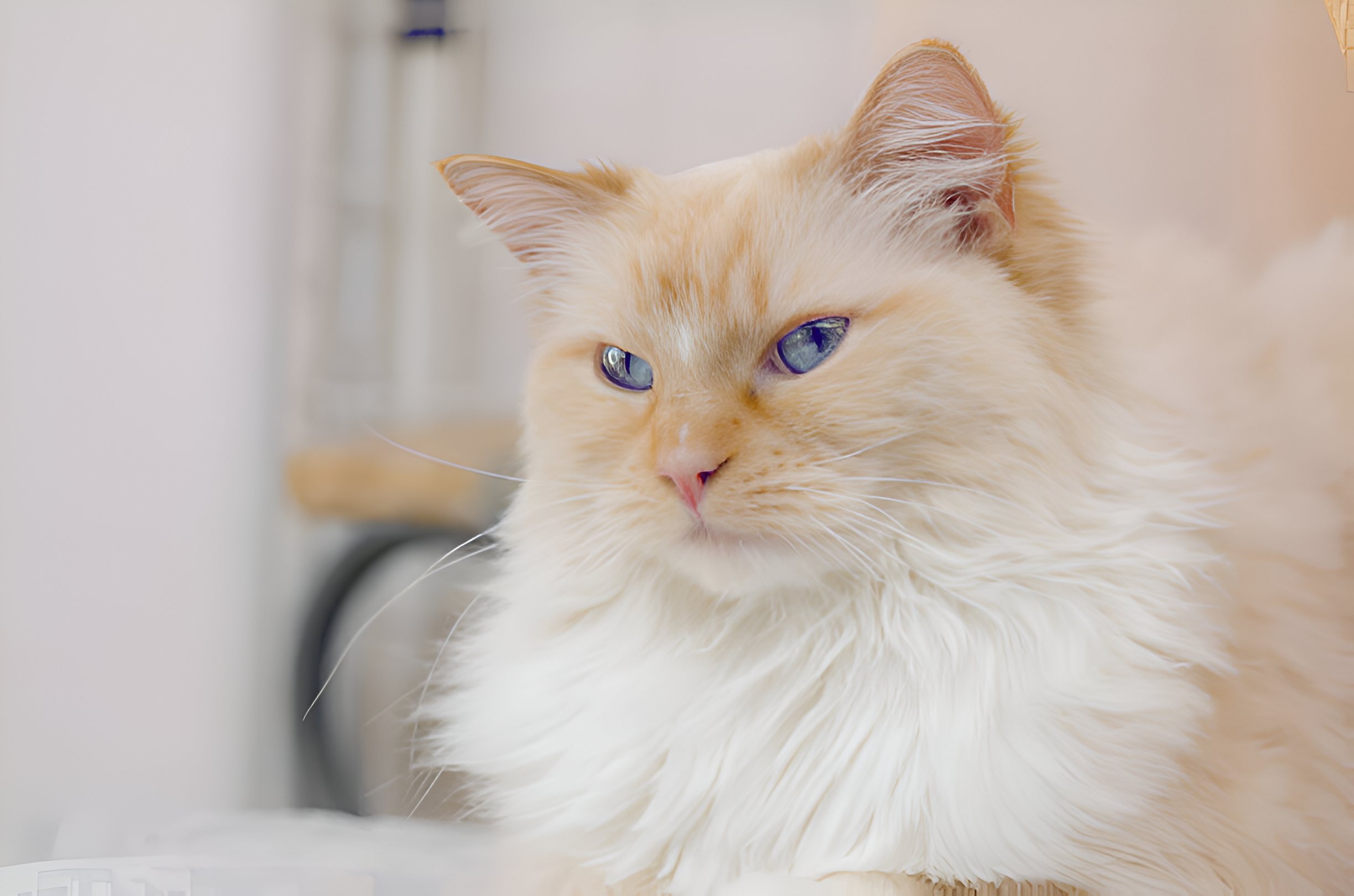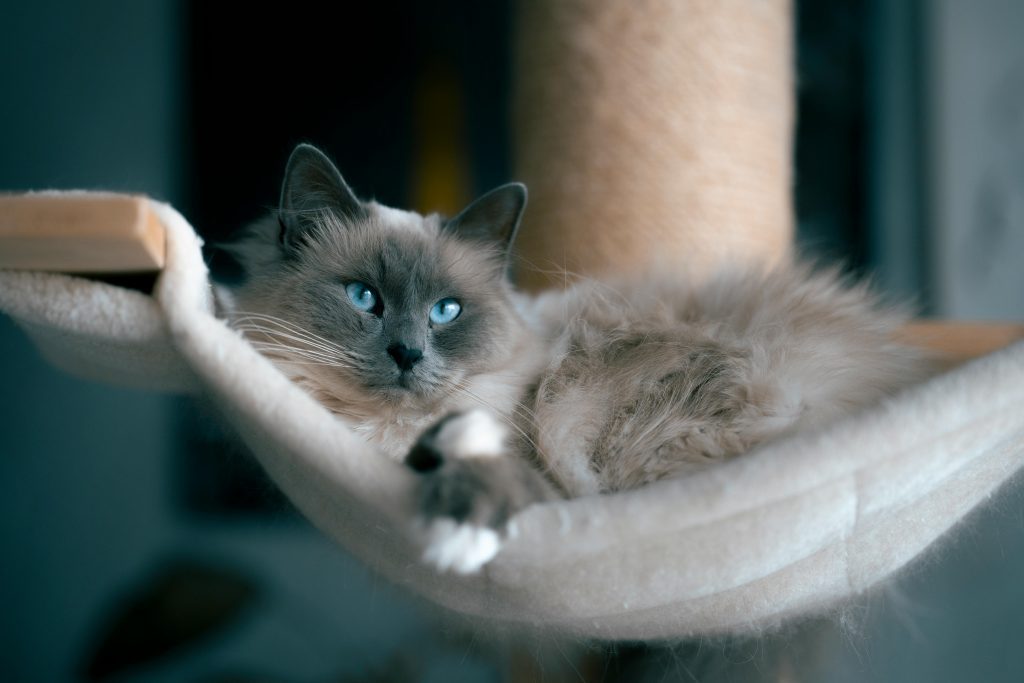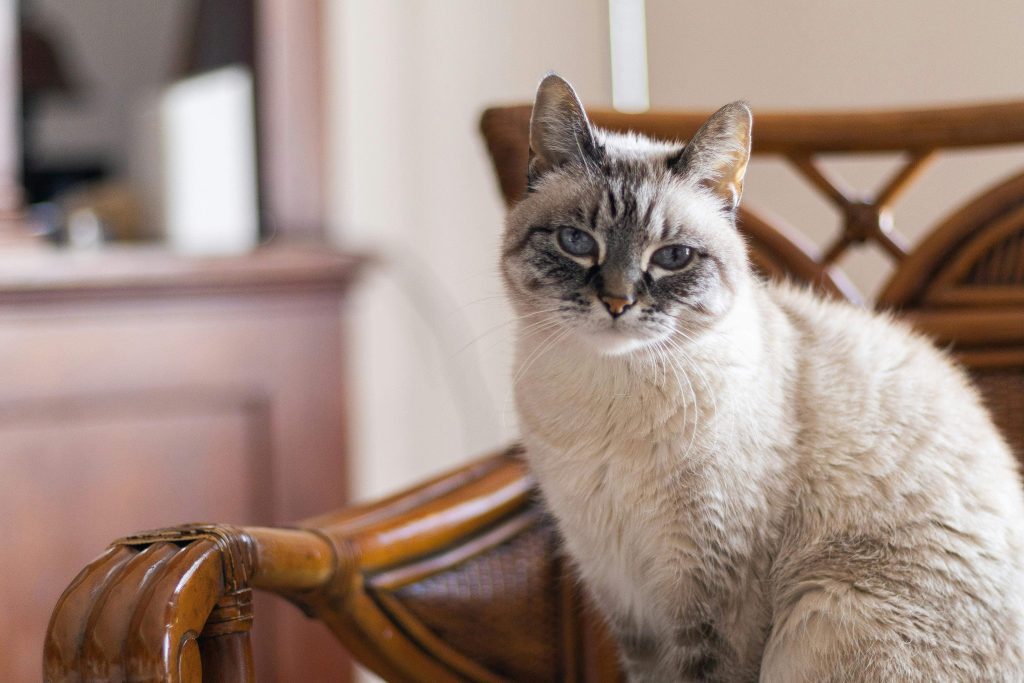With fiery orange points glowing against a creamy coat, the Flame Point Ragdoll—also called the Red Point Ragdoll—is a rare gem in the feline world. But there’s more to them than striking looks. These cats blend show-stopping beauty with a gentle, affectionate nature you won’t forget.
In this breeder– and vet-informed guide, you’ll learn about their red gene quirks, slow-developing color, grooming needs, personality, and smart buying tips.
Whether you’re curious, thinking about adoption, or simply a cat enthusiast, this is your trusted source for real-world answers. Wondering if that orange-tinged kitten is a true Flame Point? You’re in the right place.
What is a Flame (Red Point) Ragdoll?
A Flame Point Ragdoll is a striking color variation of the Ragdoll—not a separate breed—marked by vivid orange to red “points” on the ears, face, tail, and paws. This coloring comes from the sex-linked O (orange) gene, which is why males are more likely to display it; females need two copies to show solid red.
Their creamy-white base coat deepens with age, and while rarer than seal or blue points, Flame Points share the classic Ragdoll charm: gentle, affectionate, and laid-back. Think of them as Ragdolls with a fiery twist—beauty, softness, and personality wrapped in warmth.
Appearance & Physical Traits
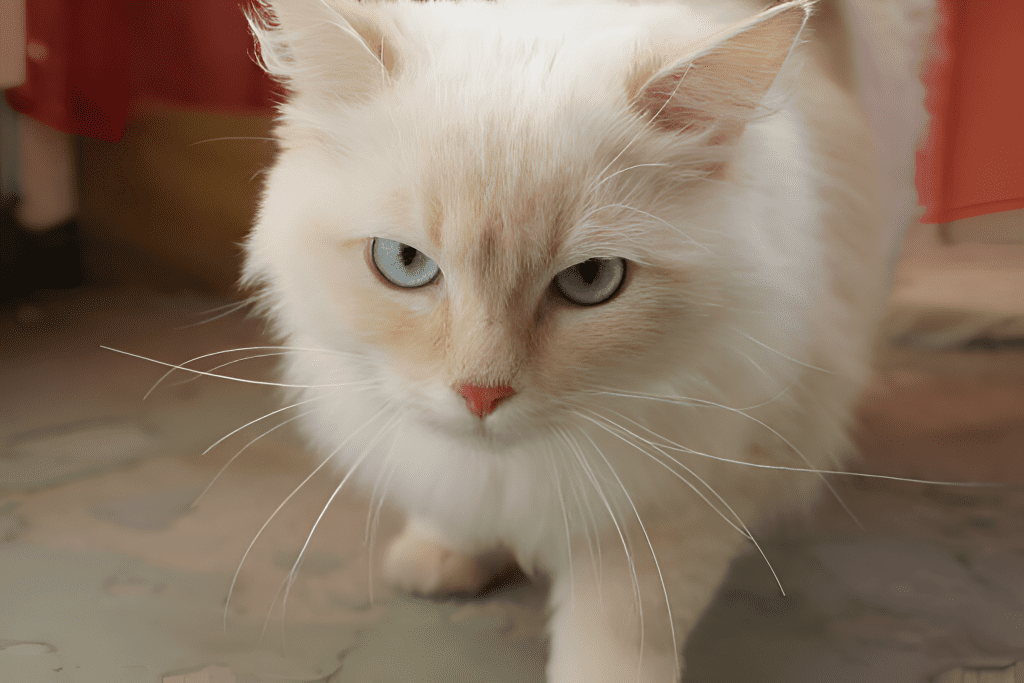
Red Point Ragdolls stand out for their soft beauty and distinctive look. Their cream or white bodies are paired with reddish-orange “points” on the ears, face, paws, and tail that deepen with age. While sometimes confused with Cream Points, Flame (Red) Points usually have a richer orange hue and stronger contrast. Here’s what makes them special:
- Coat – Semi-long, plush, and silky with a cream base
- Markings – Orange, tabby-like points that darken gradually over months
- Eyes – Large, oval, and vivid blue—an iconic Ragdoll trait
- Body – Large, broad-chested, with a muscular, heavy-boned frame
- Size – Males ~15–20 lb (6.8–9.1 kg); females ~10–15 lb (4.5–6.8 kg)
- Growth – Full size reached in about 3–4 years
If your kitten starts pale, don’t worry—their fiery color is just taking its time to bloom.
Kittens & Color Development

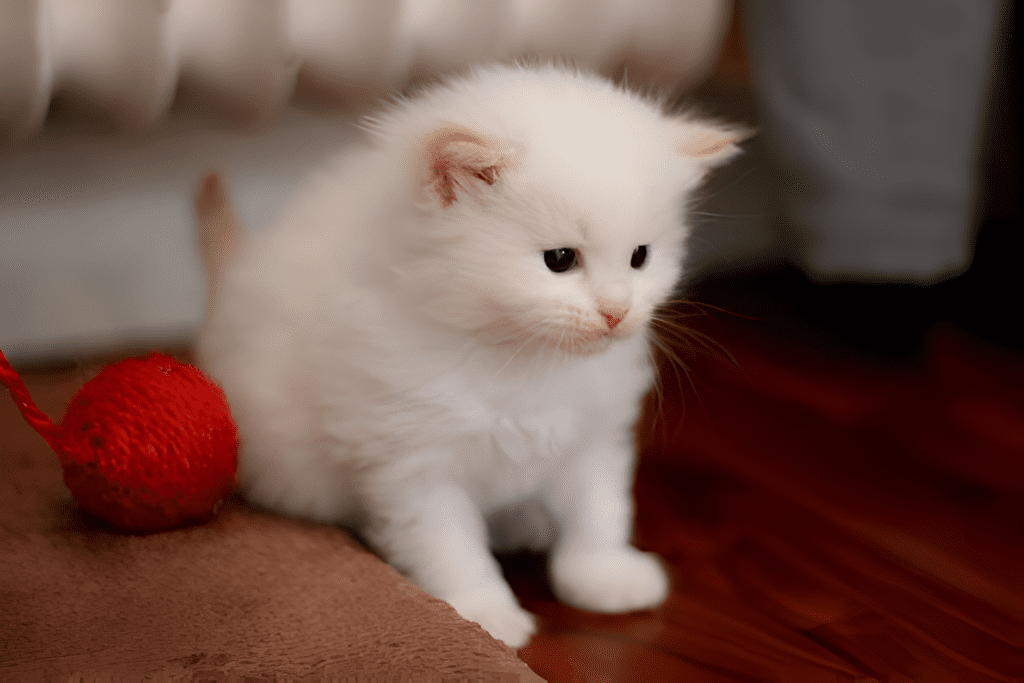
Flame Point kittens start as fluffy white bundles, but don’t be fooled—by 1–3 weeks, faint orange shading often appears on the ears, nose, and tail. Distinct points are usually visible by 8–12 weeks, while the final rich tone can keep deepening for up to 1–3 years.
This pattern comes from acromelanism, a temperature-sensitive pigmentation where cooler areas of the body—ears, face, paws, and tail—develop their signature reddish-orange hue. (Wikipedia)
During the 3–14 week socialization stage, these kittens are curious and quick to bond. Most will approach their adult size range—about 15–20 lb (6.8–9.1 kg) for males and 10–15 lb (4.5–6.8 kg) for females—by their first birthday.
Unique Variations (Lynx, Mink, Sepia)

Not all Red Point Ragdolls are alike. Beyond the classic look, there are rarer variations with subtle differences in coat, markings, and lineage. These traits often become more noticeable as kittens mature, especially between 6 and 12 weeks. Here’s how to tell them apart—and avoid some common misconceptions.
Flame Lynx Point Ragdoll
Easily spotted by soft, tabby-like stripes on the face, legs, and tail, Lynx Points add a touch of wild elegance to the flame pattern. The body remains creamy white while orange-red bars or rings develop with age. This look comes from the agouti gene, which creates the striping without changing personality—owners just say they look more “expressive.”
You Might Also Like
Lynx Point (Tabby) Ragdoll Cats – Appearance, Genetics, & More
Flame Mink Ragdoll
Minks have a warmer, velvety coat and striking aqua to greenish-blue eyes. Their deeper red tones and plush texture give them a rare, luxurious feel. Registry recognition varies—TICA accepts them, but some others may not—so it’s best to confirm with breeder paperwork. And despite myths, coat type has no link to temperament.
You Might Also Like
Mink Ragdoll Cat Guide – Patterns, Traits, Price & Care Tips
Flame Sepia or Solid Ragdoll
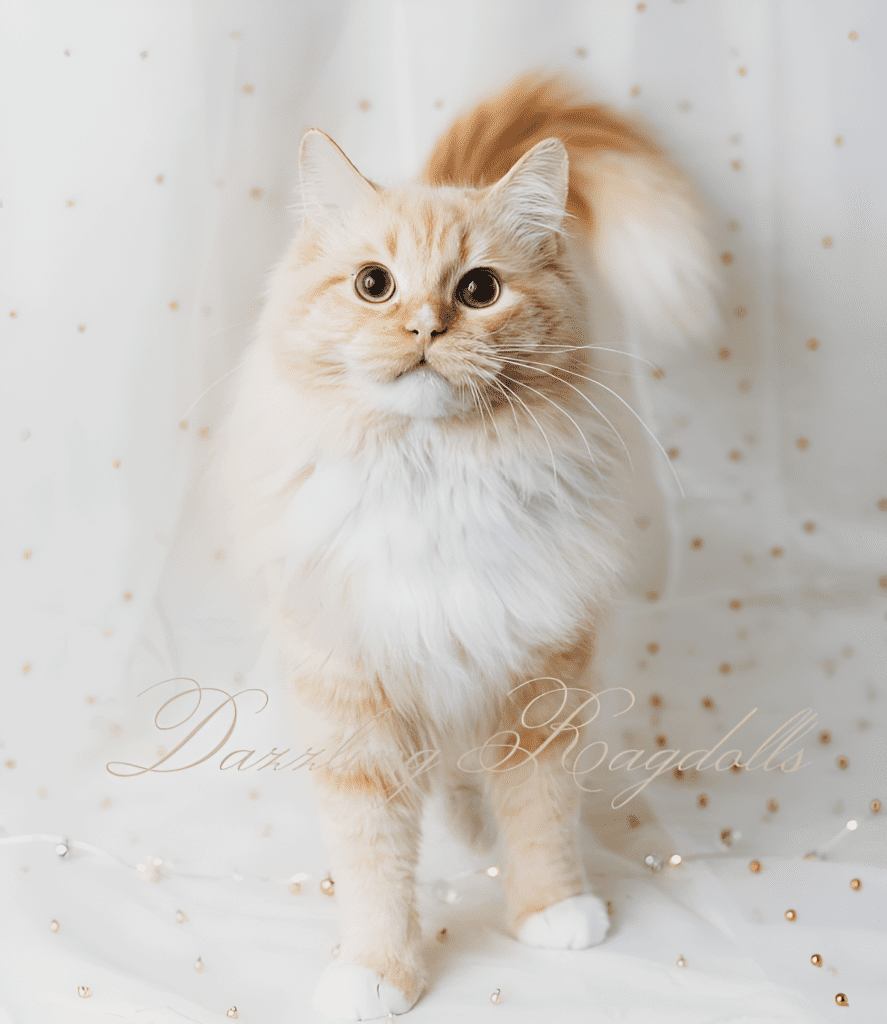
The deepest and richest in color, Sepias keep a warm reddish tone year-round. They’re sometimes mistaken for mixed breeds, so proof of pedigree is important. Eye colors can include shades beyond blue, such as green or gold, depending on lineage. While just as gentle as other Ragdolls, owners often describe them as unusually loyal and playful.
You Might Also Like
Sepia Ragdoll Cat Guide – Variations, Traits, Price & Photos
Odd Traits & Uncommon Markings
Some Flame Ragdolls break all the rules—you might spot a blaze on the forehead, asymmetrical patches, faint “ghost” striping, or even rare heterochromia (two different eye colors). These quirks are usually just cosmetic, but if you notice sudden changes in eye color, new patches, or any swelling, it’s worth checking with your vet.
Personality and Temperament
Flame Point Ragdolls are affectionate, playful, and highly social—many owners even call them the “golden retrievers of the cat world.” These red-tinged charmers often trail their humans from room to room, chirp with excitement, and curl up in a lap or across a keyboard.
While some believe red points are more aggressive, research shows Ragdolls as a whole rank among the most tolerant and friendly breeds. Compared to Seals or Blue Points, many owners find Flames a bit more energetic and expressive, but personality always varies from cat to cat.
Grooming & Care
Flame Point Ragdolls have soft, semi-long fur that may seem low-maintenance, but don’t be fooled.
VCA Animal Hospitals notes that regular grooming helps remove loose hair and dead skin cells, keeps the coat free of dirt and parasites, and spreads natural oils for a healthy shine.
While they lack a heavy undercoat, mats can still form behind the ears or under the legs if brushing is skipped. Aim for 2–3 brushings a week (daily in spring or fall) with a slicker brush or steel comb to prevent tangles. Bathe only as needed—every month or two at most, depending on activity and skin condition—and use grooming wipes for quick touch-ups.
Tip: As one professional groomer put it, “Your attention is their best coat-care secret.”
Recommended Post
Health & Screening
Flame Point Ragdolls are generally healthy, but like all purebred cats, they can be prone to certain conditions. One of the most notable is hypertrophic cardiomyopathy (HCM), an inherited heart disease; prevalence varies by bloodline, so ask breeders for recent HCM and polycystic kidney disease (PKD) screening results.
Other concerns include urinary tract issues—especially in neutered males—and weight gain due to their laid-back nature. Watch for signs like panting, vomiting, or unusual lethargy.
Their typical lifespan is around 12–17 years. Schedule annual vet check-ups, increasing to twice yearly after age 8. Discuss with your vet whether to include DNA testing, tailored diet plans, and heart ultrasounds at key life stages—early detection can make all the difference.
Recommended Post
Exercise, Training & Play
Flame Point Ragdolls may have a laid-back personality, but they still need daily exercise and mental stimulation to stay happy and healthy. Aim for 2–3 play sessions daily, each lasting 10–15 minutes.
Use interactive toys, like feather wands and puzzle feeders, to engage their hunting instincts and keep their minds sharp. Contrary to popular belief, they’re not “lazy”—their energy is often masked by their relaxed nature.
Tip: Flame Points thrive on routines, so incorporate structured playtime and praise to reinforce good behavior. For training, use positive reinforcement like treats and clicker training. And remember: a well-exercised Ragdoll is a contented one!
You Might Also Like
Male vs. Female Red Point Ragdolls
When choosing between a male or female Flame Point Ragdoll, it helps to know their subtle but noticeable differences. Males are typically larger, averaging 15–20 lbs (6.8–9.1 kg), and often tend to be more outgoing, vocal, and playful.
They thrive on attention and enjoy being in the middle of family life. Females, averaging 10–15 lbs (4.5–6.8 kg), often lean toward being more independent and quieter, enjoying a calm, predictable environment. While both can be equally affectionate, females may take more time to bond.
Overall, males may be a bit more attention-seeking, while females often prefer moments of space. Meeting both sexes in person can help you see which personality best matches your home and lifestyle.
You Might Also Like
Final Thoughts
Flame and Red Point Ragdolls are a rare and striking choice for cat lovers. With their calm, affectionate nature, they fit beautifully into family homes, getting along well with children and other pets. Their long, luxurious coats do need regular grooming to stay at their best.
Key Considerations for New Owners
- Grooming – Regular brushing is essential to keep their fur healthy.
- Health Care – Keep up with vet visits and be mindful of breed-specific health concerns.
- Living Environment – These cats thrive in quiet, interactive spaces but adapt well to active homes if given attention.
Adopting a Flame or Red Point Ragdoll can bring years of joy—just be sure to give them the care they deserve. What’s the most surprising thing you’ve learned about this beautiful breed? Share your thoughts in the comments below.

Hi, I’m Mo Pavel—a writer, researcher, and devoted animal lover. With my Persian cat Luna and two loyal German Shepherds, Rex, and Max, I live a life centered around pets. Beyond my home, I care for stray dogs, ensuring they feel loved and safe. Through Cats Question, I share insights to help pet owners create better lives for their furry companions.
